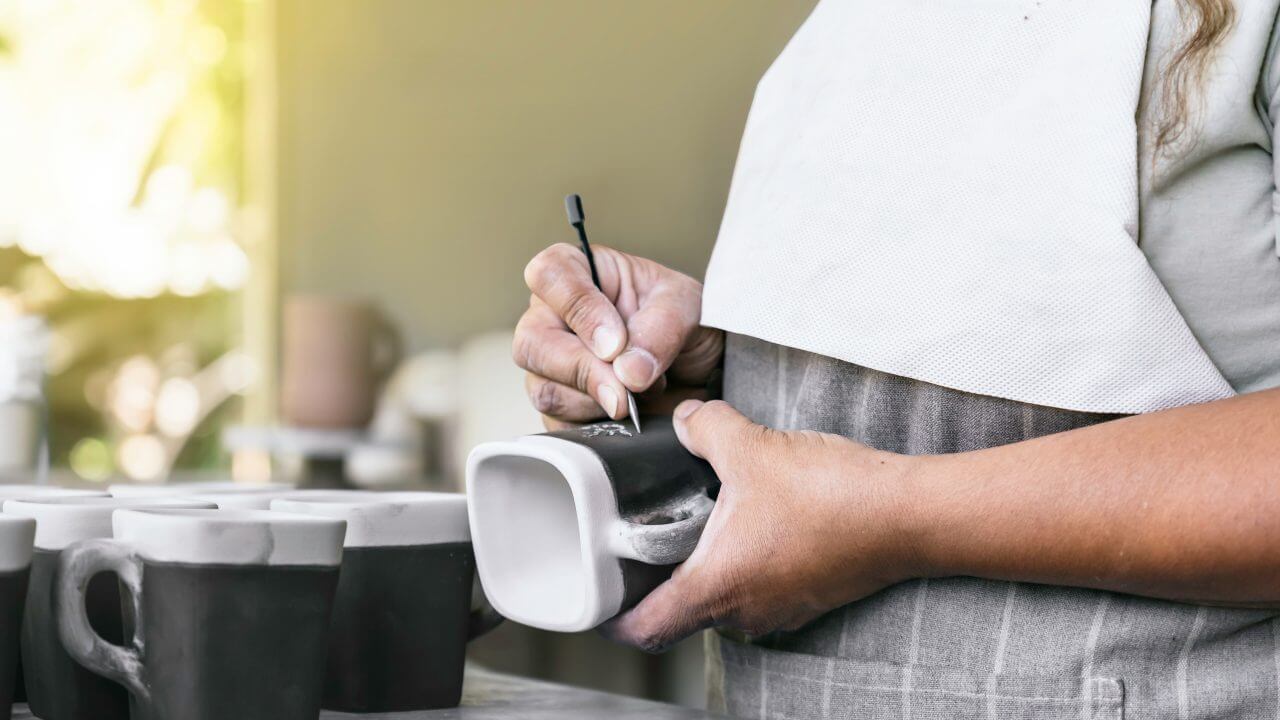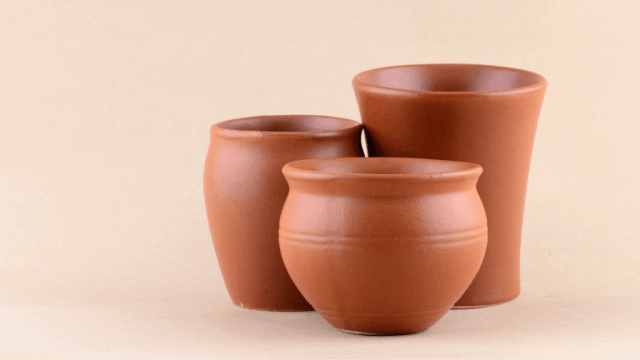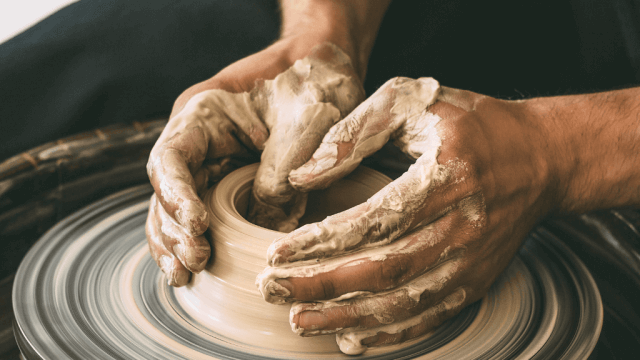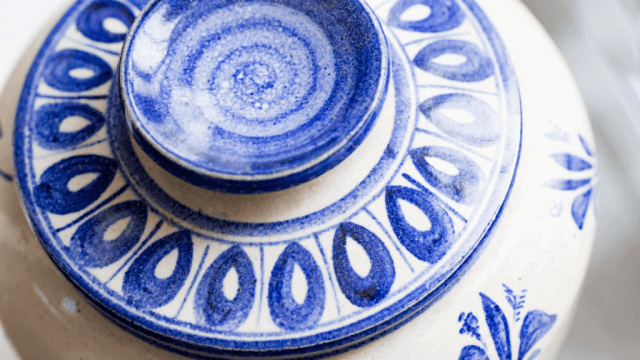Sgraffito pottery is a ceramic technique in which a design is scratched (carved or incised) into the surface of a leather-hard clay body, revealing a contrasting lower layer of clay or slip. The word “sgraffito” is derived from the Italian word “sgraffiare,” which means “to scratch.” This distinctive effect can be achieved by applying a layer of colored slip or underglaze to the wet clay surface before carving away its top layer to reveal the original clay body underneath.
Introduction to Sgraffito Pottery
Sgraffito pottery is a ceramic art form that involves scratching or incising elaborate designs onto the surface of a clay body. The process begins by applying a layer of colored slip or underglaze to a piece of greenware, which is then partially removed to reveal the clay body underneath, creating a striking contrast in color and texture.
The Sgraffito Process
Preparing the Clay Body
First, select and wedge the clay, ensuring it has the desired consistency and is free from air bubbles. Form the clay piece using wheel throwing or hand building techniques that suit your vision for the final design. Allow it to dry to the leather-hard stage before proceeding.
Applying Slip or Underglaze
Choose a slip or underglaze color that will contrast sharply with the natural clay body. Apply an even coat to the entire surface, or selectively, based on the design plan. Allow the slip or underglaze to dry slightly, but not completely, maintaining a wet enough surface for easy carving.
Designing and Carving
Sketch your desired design directly onto the piece or use a printed stencil as a guide for carving. Begin incising or carving away the colored layer using stylus, loop tools, or other preferred carving implements. Focus on intricate or larger patterns, while avoiding overly deep or shallow cuts to preserve the final appearance.
Tips and Techniques for Sgraffito Pottery
Preserve the Carved Material
Collect the carved-away slip or underglaze to reuse in future projects or to mix with other colors for new shades.
Multiple Layers for Depth
Create depth and shading by using multiple slip or underglaze layers of different colors before carving. This technique enables a complex, multi-tonal effect.
Experiment with Glazes
Experiment with transparent glazes to accentuate and protect the sgraffito design. Considering the finished look when selecting glazes, as they can alter the appearance of the piece when fired.
Test Your Designs
Before committing to a piece, consider practicing on small test samples or tiles to refine sgraffito techniques, color combinations, and overall design choices.
Maintaining Cleanliness During Sgraffito
Keep the work area and tools clean during the sgraffito process to prevent cross-contamination of colors and materials. Regularly wipe away residue from your carving tools, and ensure your hands are clean to maintain the precision and sharpness of your designs.
Combining Sgraffito with Other Techniques
Sgraffito can be combined with other pottery techniques to create even more diverse and unique designs. You can incorporate textures using stamps, roulettes, or fabric, or combine sgraffito with slip trailing or various glazing techniques to enhance the overall appearance of your pottery.
Historical and Cultural Context of Sgraffito Pottery
Sgraffito pottery has roots dating back thousands of years, with ancient examples found in Africa, Europe, and Asia. The technique gained significant attention in Italy during the Renaissance period and has since been utilized by cultures around the world. The continuous evolution of sgraffito designs and applications is a testament to its versatility and adaptability as a ceramic art form.
Inspiration for Sgraffito Designs
When searching for inspiration for sgraffito designs, consider a variety of sources, such as nature, architecture, textiles, and art. Additionally, drawing from cultural, historical, and personal experiences can produce highly unique and meaningful pottery pieces. Combining these inspirations with your own artistic style and technique will yield truly one-of-a-kind sgraffito pottery.
Firing Sgraffito Pottery
Once the sgraffito design is complete, you’ll need to fire your piece in a kiln. First, ensure that the pottery is thoroughly dried before firing to avoid cracks and other imperfections. Typically, sgraffito pieces are fired to a range of cone 06 (1830°F, 999°C) to cone 6 (2232°F, 1222°C) depending on the clay body and glazes used. Always confirm appropriate firing temperatures with the manufacturer’s specifications for the specific materials being used.
FAQ: Sgraffito Pottery
Before diving into your sgraffito pottery project, here are some questions and answers that may be helpful in understanding and perfecting this unique ceramic technique.
What type of clay is best for sgraffito pottery?
Most types of clay are suitable, but choose a clay body that doesn’t shrink excessively during drying and firing. This reduces the chance of cracks or issues with the design. Dark-colored clay provides more contrast with light-colored slips or underglazes and vice versa.
Can you use sgraffito on already fired ceramics?
No, sgraffito is a technique that requires work on leather-hard clay with applied slip or underglaze. Once a piece is fired, the clay hardens, and it is no longer possible to carve or incise a sgraffito design.
What tools can I use to create sgraffito designs?
There are several tools suitable for sgraffito, including stylus tools, loop tools, and needle tools. Some artisans also use sharp household items like toothpicks, nails, or dental tools. The choice depends on preferred working styles and desired design intricacies.
How do I prevent my design from smudging or smearing while carving?
To minimize the chances of smudging or smearing, ensure that the applied slip or underglaze has dried slightly, and the clay body is leather-hard. Work with clean, sharp tools, and keep your hands clean throughout the process to maintain design accuracy and precision.
How do I fix mistakes or errors in the design during the sgraffito process?
If mistakes occur, carefully smooth over the affected area with a moist brush or a soft, flexible silicone sculpting tool. Then, reapply a thin layer of slip or underglaze to the area, and redraw or carve the corrected design after it has dried slightly.











